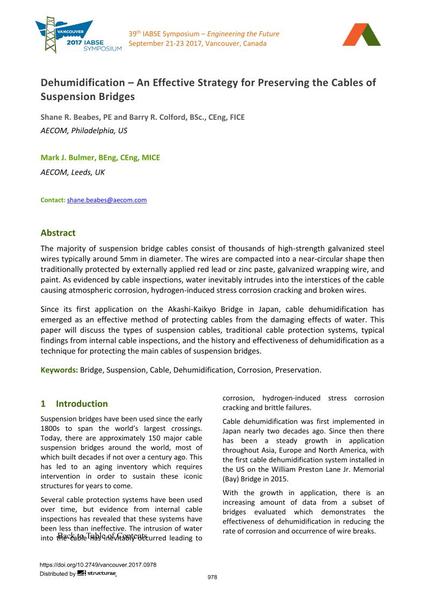Dehumidification – An Effective Strategy for Preserving the Cables of Suspension Bridges

|
|
|||||||||||
Détails bibliographiques
| Auteur(s): |
Shane R. Beabes
(AECOM, Philadelphia, US)
Barry R. Colford (AECOM, Philadelphia, US) Mark J. Bulmer (AECOM, Leeds, UK) |
||||
|---|---|---|---|---|---|
| Médium: | papier de conférence | ||||
| Langue(s): | anglais | ||||
| Conférence: | IABSE Symposium: Engineering the Future, Vancouver, Canada, 21-23 September 2017 | ||||
| Publié dans: | IABSE Symposium Vancouver 2017 | ||||
|
|||||
| Page(s): | 978-985 | ||||
| Nombre total de pages (du PDF): | 8 | ||||
| Année: | 2017 | ||||
| DOI: | 10.2749/vancouver.2017.0978 | ||||
| Abstrait: |
The majority of suspension bridge cables consist of thousands of high-strength galvanized steel wires typically around 5mm in diameter. The wires are compacted into a near-circular shape then traditionally protected by externally applied red lead or zinc paste, galvanized wrapping wire, and paint. As evidenced by cable inspections, water inevitably intrudes into the interstices of the cable causing atmospheric corrosion, hydrogen-induced stress corrosion cracking and broken wires. Since its first application on the Akashi-Kaikyo Bridge in Japan, cable dehumidification has emerged as an effective method of protecting cables from the damaging effects of water. This paper will discuss the types of suspension cables, traditional cable protection systems, typical findings from internal cable inspections, and the history and effectiveness of dehumidification as a technique for protecting the main cables of suspension bridges. |
||||
| Mots-clé: |
pont câble
|
||||

